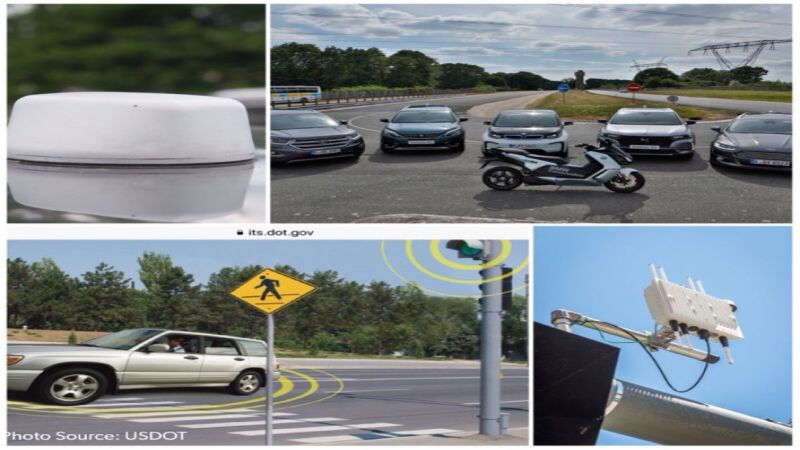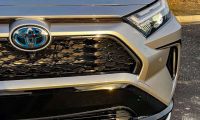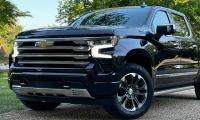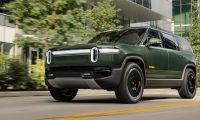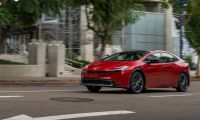As the Car Electrification Revolution is getting underway, so is the Car Autonomous Revolution as well. Although car makers swear that SAE Level 4 wheeless/pedaless modes and Level 5 wheeless/pedaless cars are coming as soon as within two years, part of that changeover process of getting both revolutions moving in the right direction is communication integration with other vehicles from other manufacturers. So far that process is not going so well. They’re battling which equipment that carries software platform, or communication method or language shall cars speak to each other so they can state their intentions and take action without colliding into one another. And since the present administration is in no mood to regulate, this may bog down the movement, maybe even cost lives:
- While technology advances in electrification and autonomy, the process requires communication between units so that there’s coordination.
- Car’s need to talk to each other so they don’t crash into each other.
- This technology is saving lives right now as its being implemented.
- DSRC is Wi-Fi based two decades old tech tried and tested used by GM and VW in their semi—autonomous vehicles on the road now.
- Innovative makers are starting to use cellular based C-V2X, used by BMW, Ford, and Daimler.
- Tesla uses C-V2X to download software updates into their cars.
- Both systems are completely incompatible and nonfunctional for each other like iOS/Android, VHS/Betamax, cars 100 years ago: gas/electric.
- The Obama Administration set up proposed rules for Wi-Fi radio based DSRC to take effect 2021, for cars and light trucks to have it by 2023.
- But now there’s a movement to V2X to try to change that.
- Like Washington gridlock, both sides are becoming encamped.
- NHTSA remains “technology neutral.”
- Whatever they decide, the sooner the better because as each side goes off on their own the more expensive it’ll become for the losing tech side to change over.
- So what will it be? Beta or VHS?
The Dilemma: VHS or Betamax?
One of the nice things about advancing technology in capitalistic markets is that it provides the opportunity of choices so consumers can decide which is best for them. Like we consumers went through about 30 years ago when Sony’s Betamax became commercially available after 10 years of metamorphosis while the industry standard of VHS was making its way, it seems the auto industry is going through its tech growing pains with deciding which equipment to use that carries the platform in which cars will be able to best communicate with one another. That transition isn’t going well. “You’ve got public agencies who want to deploy, but we don’t have a standard, so what do I buy?” Kirk Steudle, director of Michigan’s Department of Transportation and a supporter of the DSRC standard, asked recently of the New York Times. “Betamax, or a VHS?”
Sometimes in the tech advance race an ultimate decision has to be made by someone, some company, or some institution as to which technology should be used across a whole platform to give the maximum benefit to the maximum amount of consumers. While most of us probably use mostly the Windows Operating System at work, Apple overtook Microsoft to become the dominant platform for personal computer use, especially for cellular devices. One hundred years ago electric and gas cars were neck and neck until Henry Ford blew the electrics off the roadway for 100+ years until probably the next two decades when they’re expected to be neck and neck again.
Whatever we decide, the sooner the better we make up our minds to unify implementation, the better, because if this becomes another can we kick down the road, like the national debt, our federal budget deficit, our infrastructure, or our total consumer debt like the growing student loan and subprime car loan bubble crises, the cost to fix this like those things, will become exorbitantly expensive, especially when dealing with very expensive and complicated AI artificial intelligence technology.
DSRC v. V2X:
We are once again at that junction in the roadway in our journey toward a more perfect society: as full robotization gets underway, parts of the AI artificial intelligence technology needs to be implemented pieces at a time that immediately start to benefit us. This problem seemed to be solved 10 years ago when the auto makers initially agreed to use Wi-Fi based dedicated short range communications, or DSRC, so that cars can begin to become aware of themselves and each other to start communicating their intentions so they don’t go haywire, if you will. So the Federal Communications Commission (FCC), the National Highway Traffic Safety Administration (NHTSA), and the US Department of Transportation (DOT) helped them along by setting aside radio waves, doing a study, and proposing a rule that doesn’t go into effect until 2021. This is two decades old technology that took leaps and bounds to get here, that some say is becoming obsolete. But it has been throughly tested, and being true to their word of putting new tech into cars ASAP, GM already has it up and running in Cadillacs, and not to be outdone, their direct competitors Toyota and Volkswagen have quickly followed suit. The problem with this technology experts say, is that it’ll be expensive to take down and replace with C-V2X. With the semi-autonomous cars already in production like Cadillac with its Super Cruise feature that is similar to Tesla’s AutoPilot, it entails something similar to a product recall, a proposition into the hundreds of millions of dollars.
And then came the more recent, and some say more advanced, V2X or C-V2X cellular based technology. This is the technology that allows car companies like Tesla to allow their entire legacy fleet of vehicles on the road today since 2012 and since the start of FULL production day 1 (not limited production, which started in 2008 with Roadster I) to download updated software into the cars for advancements and changes to improve its features. An example of this is Tesla’s response for complaining customers about quick battery drain when they park their electric car but stay inside to sleep or, well, whatever. Tesla calls it “camping mode,” when the car is parked for a prolonged time to use the interior lights, heater, or air conditioner without rapidly draining the batteries dead (this excludes the Roadster I, as that car was not a full production car. It was a hybrid/combo bespoke/limited edition halo/test mule for Tesla to introduce the brand and to see what would work in a full production car, the Model S being the first benefactor). This entailed a software update to each car using C-V2X technology.
This is also the same technology that allows things for a parent to monitor a baby carriage-restrained child in the back of a vehicle or another remote location with live streaming video while they’re driving, things never imagined by the public, let alone car makers by just a few years ago. Well, it’s here, and the technology is compelling, but not as tried and thoroughly tested as DSRC.
Before Comparing, This is What Both Do: Vehicle to Vehicle Connectivity V2V:
DSRC and C-V2X are two different kinds of communication technologies that the federal government calls “vehicle to vehicle connectivity,” enabling vehicular AI artificial intelligence software to communicate with another to give themselves a reference point to self-awareness and situational awareness. “Who or what am I and who or what are you, where are you, where are you going, and what are you doing?”, is the best way to describe what these two technologies help AI artificial intelligence do in our future autonomous driverless cars. These pieces of equipment deliver the information to the car so it can decide what to do.
This is the magic of vehicle connectivity: instead of a sign on a roadway stating “Bridge Ices Before Road,” the bridge and its sign give your car real time data on how, where it is at and to what extent is it in its freezing process, for the car to take appropriate action. Instead of a traffic light just changing signals for a car’s sensors to pick up this information and start to slow to a stop, the traffic light can send out messages “calling all cars,” and based on the feedback, it can adjust patterns to let a volley of cars through a light longer than usual to enhance the flow. The feedback could also hold all the traffic lights so that emergency vehicles, also connected, can take priority over all other signals and vehicles. First responders and civilians no longer will be injured in crashes in which first responders are in the process of responding. This is also one of the ways those spectacular, sometimes outrageously ridiculous self-implosive California high speed police pursuits come to a permanent dead halt as a late 20th/early 21st century phenomena.
NHTSA says this vehicle to vehicle technology, whichever one is used, can immediately begin to cut down on a whopping 80% of crashes. This equipment helps our cars to think like sentient beings and to get a reference point as to where they are so they they don’t interfere with one another. DSRC is Wi-Fi radio based, and C-V2X is cellular based.
According to the USDOT these are some of the benefits to vehicle to vehicle technology:
1. Safety: 2013 there were 5.6 million crashes, according to the NHTS, resulting from 32,719 deaths. They say this can be reduced by 80% as the technology is being implemented. a. Red light violation warnings: 250,000 crashes and 2,000 deaths/year.
b. Curve speed warnings: 169,000 crashes, and 5,000 fatals. c. A 25% reduction in winter related crashes on the highway.
2. Better Mobility: In 2014 US highway users wasted a staggering 6.9 billion hours being stuck in traffic, according to Texas Transportation Institute (TTI). With technology such as GPS, AI artificial intelligence, and vehicle to vehicle technology, connected vehicle mobility will enable more efficient navigation, reduce congestion and delays to improve operators’ use of the roadways, particularly with fleets. a. Signal Control Applications: (AI signal systems, freight and transit signal priority) reduce travel time by up to 27%. b. First responders’ response times: reduce number of stops by 15% and the arrival times by up to 23% c. Environmentally optimized and harmonized adaptive cruise control and can reduce freeway travel times by up to 42%.
3. Environment: The TTI says in 2014, that a staggering 3.1 billion gallons of fuel was wasted from vehicles stuck in traffic. Connected mobility will enable drivers to make better green choices. a. Fuel savings up to 22%. b. A 20% reduction in the miles traveled. c. An 11% reduction in CO2 emissions and fuel consumption.
Choose Your Battles Carefully: Who’s on Which Side:
So you get a better sense at what’s at stake even at this moment writing this, and the reasons for government apprehension to intervene while these technologies develop and the industry fights it out. You can tell, the divisions are leading to camps of engineers inside the auto industry that are running deep and decisive and divisive, almost, but not quite as ugly, not yet, like American politics. Are you conservative DSRC or more progressive C-V2X? Some aspect of it has a Ford v. GM kick to it, in another sense there’s the ones known more for being performance luxury brands like BMW and Daimler v. the ones that are straight forward traditional brands whose performance or luxury divisions are more background than foreground, like GM, VW, and Toyota, whose house brands and Chevrolet are the baseline and most selling brands. VW Group, committed to DSRC joined 5GAA and seems to be what is the equivalent of the China abstention vote in the UN General Assembly. It’ll go with the flow as long as it’s all about self interests, otherwise in conflict it’ll side with what it already has. Subdivision Audi went on their own to join 5GAA even though the VW Group deployment next year goes across all brands, all models, and all ranges.
This is the DSRC side: GM, VW, Toyota. Standard on all Cadillac CTS sedans. VW and Toyota make it standard on all cars across the brands next year.
Here’s the C-V2X side: Daimler, Audi, BMW, Ford, Tesla, Faraday Future. The 5G Automotive Association and Qualcomm and several other tech and non-tech entities are the non-automotive interests. http://5gaa.org
In light of recent developing news about Faraday Future and in this case especially Lucid Motors with both their positive prognoses and production timetables, this reporter believes both companies should be included in the conversation as game players about the industry at this point. This reporter wasn’t able to confirm, but based on the software update technology Tesla is presently using, the logical progression is that future start up electrics like Lucid, seeing what Tesla is capable of doing with it, will follow suit. As noted above, Faraday is a member. But what you are a member of clearly doesn’t necessarily represent where you take a stand, as VW shows.
Each Side Staking Their Claim:
But in other circles, the positions are quite clear: John Kenney, director of the Toyota InfoTechnology Center, said his company was ready to move ahead with the DSRC standard. “G.M. is online, too,” he said to the New York Times. “Now, there’s a potential risk that maybe it’s not going to be DSRC. That just impedes deployment.”
Here’s the Ford C-V2X side: “People assume that just because something is here now and they’ve been working on it for 15 or 20 years, it will be here 15 years from now,” said Jovan Zagajac, technology manager in Ford’s Connected Vehicle and Services group and a member of the 5G group’s board, to the New York Times. “Well, the world has changed.”
BMW states its case: “This will make it much easier to retrofit vehicles and also give the benefits of C-V2X to other vulnerable road users, such as cyclists and pedestrians,” Joachim Goethel, the leader of BMW’s 5G connectivity initiatives, told the NY Times.
And finally what could be considered be the Federalist Papers or Common Sense positions during the American Revolution, or a presidential debate between DSRC and V2X candidates:
Representing the Daimler territory of V2X is here.
V.
Representing the Toyota territory of DSRC is here.
Some organization and even states are staking positions in the hopes of speeding their technology along, Michigan is one them, which has started deploying DSRC into traffic control devices across the state. The Coalition for Safety Sooner have petitioned a letter to DOT secretary Elaine Chow and Budget director Mick Mulvaney to get the DSRC ball rolling, as if they were amicus briefs to the Supreme Court on some social issue.
Here is the government’s position: Heidi King, deputy administrator at the National Highway Traffic Safety Administration, said the Department of Transportation was “technology neutral” on communication protocols. “While our past research has centered around DSRC — because that was the only technology available — we are also exploring other technologies, including Cellular V2X,” she said in an email to The NY Times.
The Differences:
Here now are the differences.(Edit Note: This reporter has not taken a position on vehicular connectivity, as this is a report, not opinion and analysis. This ext section is analytical but he tries best to remain neutral).
DSRC is the FORTRAN or COBOL of the AI artificial intelligence/communication/connectivity world. It’s a very important first step to developing this technology. To this day, we owe a great sense of gratitude to FOTRAN and COBOL to get us here to AI technology. But those two computer programs were only first steps. So is DSRC. In the case of the other two early programs, we’ve since moved way on. As the first conveyance of AI vehicular communication, its applications, like FORTRAN and COBOL are now, extremely limited. DSRC’s sole function is limiting and already becoming old, but it’s custom made for this application, it’s ready now, and it does a pretty damn good job of avoiding crashes and keeping peace in the traffic world. That’s what we made it for. Amen.
DSRC has more testing mileage, tried and true, and is ready to be deployed. NOW. Because of its testing, some say it does a better job of traffic management and collision avoidance than V2X, which some say, still needs development, and more testing to perfect it. DSRC can save lives right NOW, and in fact some say, whoever stops the deployment of this technology NOW, will have blood on their hands. The US sells within itself approximately 10 million new vehicles a year. That’s 33,000 deaths a year at 80% we can start to cut down right NOW. That’s up to and/or eventually 26,400 friends, family, children, relatives, teenagers, office and factory colleagues saved, NOW. Period.
Americans are starting to do with their cell phones, the same thing they’ve always been doing with their cars, and that’s keeping them longer. The average length of American car ownership was 10 years, since we’re between economic downturns, the trend is moving to 15 years. With this right now available DSRC technology ready to go, the potential of millions of vehicles to have it and to save lives is almost priceless. By skipping over these vehicles for new technology, a missed generation of cars means millions of accidents and hundreds of thousands of deaths. It’s one of those things until you have a personal or family tragedy to lose a loved one to wonder, “would that technology have prevented this?”, to never really know.
As far as security, there are no over the air software updates for DSRC. If a fix is required, you need to go to the dealership retailer for a technician to install a patch. It’s Wi-Fi based, which based on my previous report about hacking to steal cars doesn’t make it easier ir harder to steal, there just isn’t network to break into like V2X.
This is the sticking selling point of DSRC: it’s the cheaper, it’s ready, its sole purpose built, and it can save lives right NOW.
V2X is the moneymaker. Ahah, you must be thinking, the real motive behind this finally reveals itself. True, but let’s hear them out. Besides its collision and traffic management capabilities, it’s connected to a cellular network, which means there are other applications it can be used for, all or most of them money making, like streaming movies or events live, but some of them are life saving. Most of the things we’ve done to the cellphone means the same possibilities for a car are expansive. Some say, let’s not shut this door now. Some others may balk and say, “well, then the choice is obvious, I choose safety over comfort,” to go back to DSRC. The counterpoints begins with Level 4 and 5 autonomy when you’re just sitting in the car. Yeah you could read a book, but V2X can give at least your kids a source of entertainment, and if you never had kids, then you’ll never understand how important that is when they’re sitting inside a car with nothing to do.
With V2X there are public safety implications for argument’s sake. With V2X you can turn your whole car into a giant camera sensor array starting with your cell phone in the car to the car itself, in case of an emergency, or if rescue/first responders need a real time on the ground assessment of what the issue is at hand. Just a handheld could suffice, but a whole vehicle with this capability makes it much more easier. You just can’t do that with DSRC. It’s like trying to do the things you can do with Mac OS or iOS, like make an app, that you just can’t do with FORTRAN.
As far as security for a V2X car, they can be just as easy or difficult to steal or hack into based on the equipment you’re using. Based on my previous report of thieves hacking into Tesla cars, they’re at least two layers thieves need to get through if they want access to the network. The first layers requires the right equipment and know how the layer(s) into the network is another Pandora’s box. The difference between stealing a V2X and a DSRC car is that the hack is a key dupe for a Tesla car, for the rest you shut the engine off and the hack does right there.
This is the sticking selling point of V2X: it is retrofitable into vehicles, both the hardware and the software are much more flexible in application, it is upgradable with a download software, pedestrians and bicyclists benefit from its use too. DSRC can’t do all that.
One Last Thing to Think Of:
You can now understand the emotion that gets involved, like our political beliefs, that one side says some factions of the auto industry are playing with people’s lives so that they can get a better technology, or make more revenue streams off of V2X. It’s the same kind of rationality that people make about hydrogen technology in the auto industry, those that are willing to put off BEV technology in the hopes that hydrogen fuel cell technology will improve to be universally applied, and that hydrogen fuel cell is the true compromise between BEV and gasoline. What they don’t consider however, is the urgency of the coral reefs disappearing, the intensifying tropical storms killing more people, the droughts that follow the ravaging wildfires across Siberia and North America, and the polar ice caps being almost gone. How long can we or should we wait for those things?
So what will it be? Electric or gas? iOS or Android? Windows or Mac? VHS or Betamax? DSRC or V2X?
Life or Death? Now or later?
Photos courtesy either Michigan DOT (the DSRC device on sign post and on top of car roof, USDOT of traffic intersection with emitting signals, or 5GAA, the photo of the cars and scooter, the brands that use V2X,
How do you feel about the DSRC V2X debate? Let us know below!



